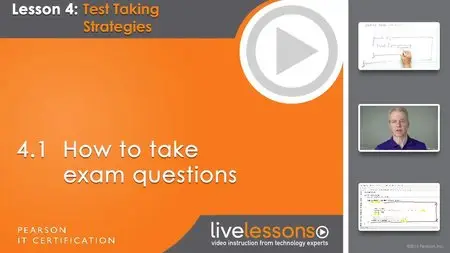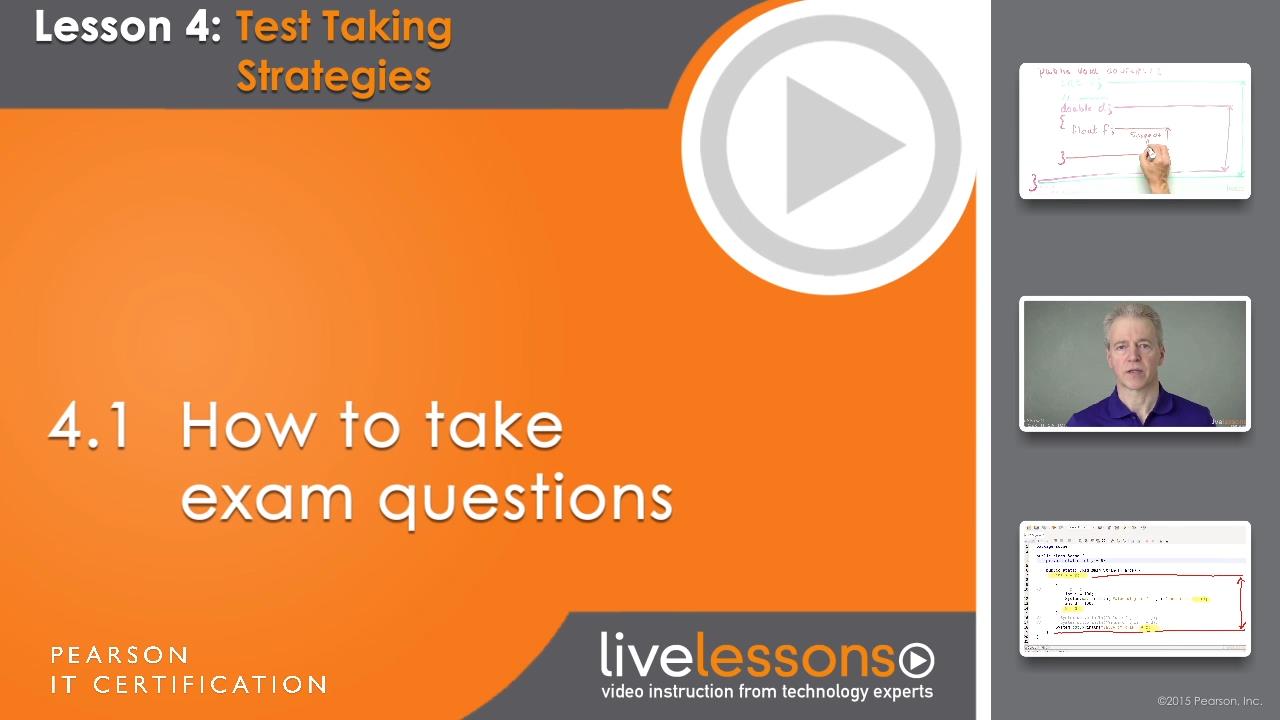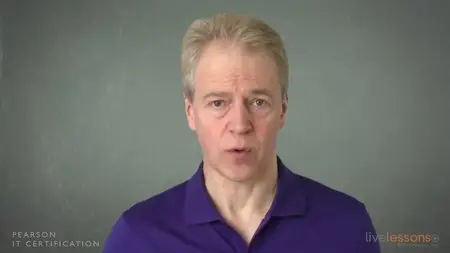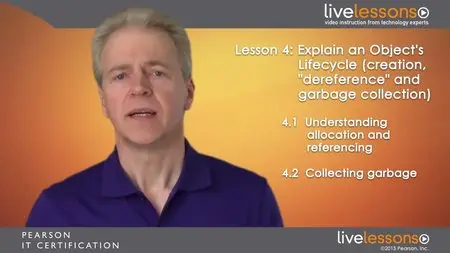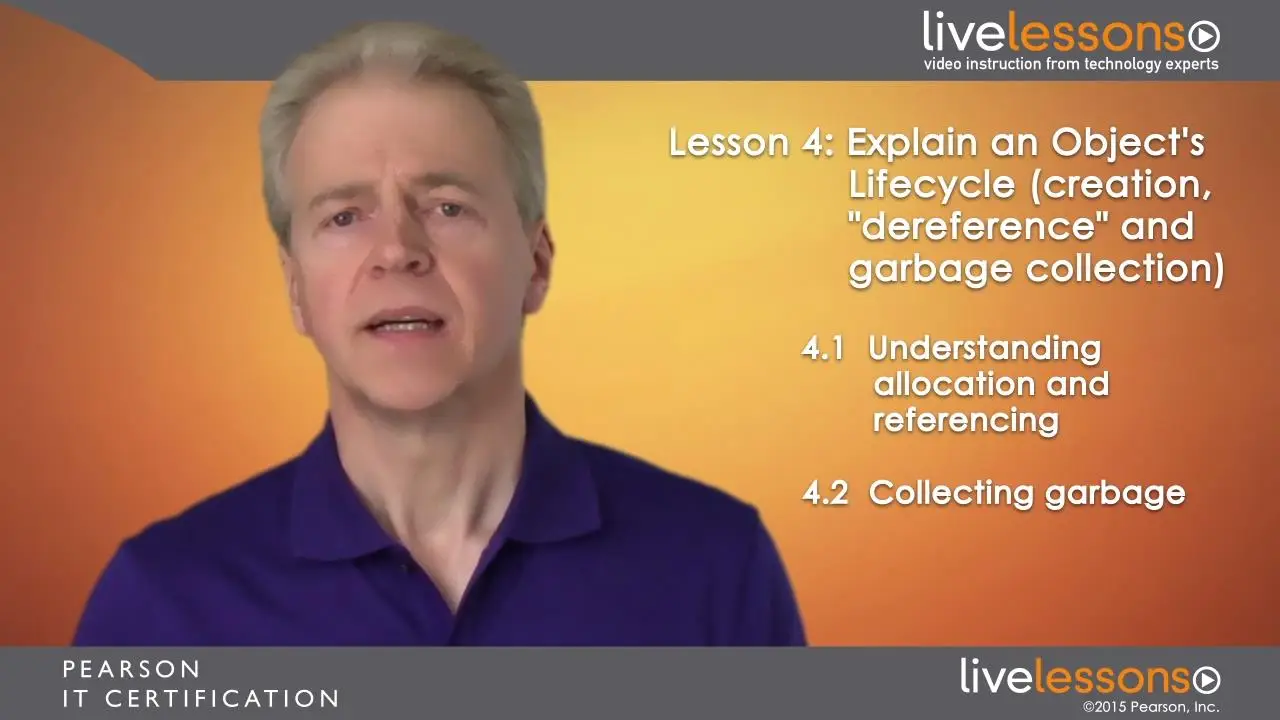LiveLessons - Oracle Certified Associate, Java SE 7 Programmer Exam (1Z0-803)
English | Feb 10, 2015 | ISBN: 0789753677 | mp4 | H264 1280x720 | AAC 2 ch | 17 hrs 11 min | 7.81 GB
eLearning
English | Feb 10, 2015 | ISBN: 0789753677 | mp4 | H264 1280x720 | AAC 2 ch | 17 hrs 11 min | 7.81 GB
eLearning
Oracle Certified Associate, Java SE 7 Programmer Exam Complete Video Course is a comprehensive training course designed to help you master the Java Certified Associate exam. The course brings the Java Certified Associate exam topics to life through the use of real-world live instruction, demonstrations, and animations, so these foundational Java programming topics are easy and fun to learn. Simon Roberts—a leading Java instructor, trainer, book author and video trainer, and creator of the original Sun Certified Programmer, Developer, and Architect certifications for Sun Microsystems—will walk you through each topic covered in the exam, so you have a full understanding of the material. He begins with an introduction to the Oracle Certification program and also discusses preparation and test-taking strategies, so you can begin your training confidently. Simon then dives into the exam topics, covering all objectives in the Associate exam using a variety of video presentation styles, including live whiteboarding, code demonstrations, and dynamic KeyNote presentations.
Skill Level
- Beginning to Intermediate
Who Should Take This Course
- The primary audience includes candidates for the Oracle Certified Java SE 7 Associate Exam; however, anyone interested in building a basic competence in the Java programming language will benefit from using this course.
Course Requirements
- The audience should have a basic knowledge of Java or another object-oriented programming language in the syntactic traditions of C/C++. For example, a candidate with a good knowledge of C# should be able to benefit from this material, even if one does not have prior experience in Java.
Module 1 Before you begin
Lesson 1 Why would i take the oracle certified associate java programmer exam?
Lesson 2 The path to certification
Lesson 3 Preparation strategies
Module 2 Java basics
Lesson 1 Define the scope of variables
Lesson 1.1 The meaning of scope, blocks, and curly braces
Lesson 1.2 Special cases of scope
Lesson 2 Define the structure of a Java class
Lesson 2.1 Java class files: contents and naming rules
Lesson 2.2 Java classes: the class, member variables, methods, and constructors
Lesson 3 Create executable java applications with a main method
Lesson 3.1 Creating executable Java applications with a main method
Lesson 4 Import other java packages to make them accessible in your code
Lesson 4.1 About packages and their purpose
Lesson 4.2 Statement order, wildcard imports, importing sub-packages, and handling duplicate class names
Module 3 Working with Java data types
Lesson 1 Declare and initialize variables
Lesson 1.1 Using the general form of simple declarations
Lesson 1.2 Using the general form of initialized declarations
Lesson 1.3 Understanding integer primitive types literal forms
Lesson 1.4 Understanding floating point primitive types literal forms
Lesson 1.5 Understanding logical and character primitive types literal forms
Lesson 2 Differentiate between object reference variables and primitive variables
Lesson 2.1 Using the == operator with primitives and references
Lesson 2.2 Understanding method argument passing
Lesson 3 Read or write to object fields
Lesson 3.1 Selecting a field from a reference expression
Lesson 3.2 Using "this" to access fields
Lesson 3.3 Code examples
Lesson 4 Explain an object's lifecycle (creation, "dereference" and garbage collection)
Lesson 4.1 Understanding allocation and referencing
Lesson 4.2 Collecting garbage
Lesson 5 Call methods on objects
Lesson 5.1 Invoking a basic method and expressions that have behavior
Lesson 5.2 Invoking overloaded methods
Lesson 5.3 Calling overridden methods
Lesson 5.4 Distinguishing overridden and overloaded methods
Lesson 6 Manipulate data using the stringbuilder class and its methods
Lesson 6.1 Understanding the common StringBuilder constructors
Lesson 6.2 Using methods that modify StringBuilders
Lesson 6.3 Using methods that read and search in StringBuilders, and using methods that interact with the internal storage of StringBuilders
Lesson 7 Creating and manipulating Strings
Lesson 7.1 Creating Strings
Lesson 7.2 Understanding common String methods: immutability
Lesson 7.3 Using common String methods
Lesson 7.4 Using common String methods to perform comparisons
Module 4 Using operators and decision constructs
Lesson 1 use Java operators
Lesson 1.1 Using operators, operands, and expressions
Lesson 1.2 Using arithmetic operators + -* / %
Lesson 1.3 Using the plus operator with Strings
Lesson 1.4 Promoting operands
Lesson 1.5 Using increment and decrement operators
Lesson 1.6 Using shift operators
Lesson 1.7 Using comparison operators
Lesson 1.8 Using logical operators
Lesson 1.9 Using short-circuit operators
Lesson 1.10 Using assignment operators
Lesson 1.11 Understanding assignment compatibility
Lesson 1.12 Using the ternary operator
Lesson 1.13 Using other elements of expressions
Lesson 2 Use parentheses and operator precedence
Lesson 2.1 Using parentheses and operator precedence
Lesson 3 Test equality between strings and other objects using == and equals()
Lesson 3.1 Understanding the meaning of == and the intended meaning of equals()
Lesson 3.2 Determining if equals() is implemented, and implementing equals()
Lesson 4 Create if and if/else constructs
Lesson 4.1 Understanding the basic form of if and if/else
Lesson 4.2 Using braces with if/else. Effect of “else if”
Lesson 4.3 Understanding the if/ else if/ else structure
Lesson 5 Use a switch statement
Lesson 5.1 Using the general form of switch, case, break, and default
Lesson 5.2 Code examples for the general form of switch
Lesson 5.3 Understanding break
Lesson 5.4 Identifying switchable types
Module 5 Creating and using arrays
Lesson 1 Declare, instantiate, initialize and use a one-dimensional array
Lesson 1.1 Understanding simple array declarations, and variables of array type
Lesson 1.2 Instantiating an array, array length
Lesson 1.3 Initializing arrays by iteration, array indexes
Lesson 1.4 Using a combined declaration and initialization of arrays
Lesson 1.5 Using immediate array creation not in a declaration
Lesson 1.6 Initializing arrays by copying
Lesson 2 Declare, instantiate, initialize and use multi-dimensional array
Lesson 2.1 Declaring multi-dimensional arrays
Lesson 2.2 Using immediate initialization of multi-dimensional arrays
Lesson 2.3 Using iterative initialization of multi-dimensional arrays
Lesson 2.4 Code examples for multi-dimensional arrays
Lesson 3 Declare and use an ArrayList
Lesson 3.1 Understanding the purpose and benefits of ArrayList
Lesson 3.2 Declaring and initializing ArrayList
Lesson 3.3 Using common methods of, and uses of, ArrayList
Lesson 3.4 Investigating documentation and code for ArrayList
Lesson 3.5 Understanding simple generics with the ArrayList
Module 6 Using loop constructs
Lesson 1 Create and use while loops
Lesson 1.1 Creating and using while loops
Lesson 1.2 Code examples of the while loop
Lesson 2 Create and use for loops including the enhanced for loop
Lesson 2.1 Understanding simple use of the for loop
Lesson 2.2 Understanding the initialization section of the for loop
Lesson 2.3 Understanding the test section of the for loop
Lesson 2.4 Understanding the increment section of the for loop
Lesson 2.5 Omitting sections of a for loop
Lesson 2.7 Understanding the simple use of the enhanced for loop
Lesson 2.8 Identifying the valid targets of the enhanced for loop
Lesson 2.9 Using the enhanced for loop with generic collections
Lesson 2.10 Code examples for enhanced for loops
Lesson 3 Create and use do/while loops
Lesson 3.1 Creating and using do/while loops
Lesson 4 Compare loop constructs
Lesson 4.1 Comparing while and do while loops
Lesson 4.2 Comparing while and simple for loops
Lesson 4.3 Comparing while and enhanced for loops working on iterables
Lesson 4.4 Comparing while and enhanced for loopsworking on arrays
Lesson 5 Use break and continue
Lesson 5.1 Using break from single loop
Lesson 5.2 Using continue in a single loop
Lesson 5.3 Using a labeled break from multiple loops
Lesson 5.4 Using a labeled continue from multiple loops
Module 7 Working with methods and encapsulation
Lesson 1 Create methods with arguments and return values
Lesson 1.1 Creating Methods
Lesson 1.2 Code example
Lesson 2 Apply the static keyword to methods and fields
Lesson 2.1 Comparing class fields and object fields
Lesson 2.2 Using static on methods
Lesson 2.3 Code example
Lesson 3 Create an overloaded method
Lesson 3.1 Understanding basic syntax of overloaded methods
Lesson 3.2 Understanding rules and guidance for using overloaded methods
Lesson 3.3 Code example
Lesson 4 Differentiate between default and user-defined constructors
Lesson 4.1 Differentiating between default and user defined constructors
Lesson 5 create and overload constructors
Lesson 5.1 Creating and overloading constructors
Lesson 6 Apply access modifiers
Lesson 6.1 Using the access modifiers public and private
Lesson 6.2 Using default access and the protected modifier
Lesson 7 Apply encapsulation principles to a class
Lesson 7.1 Designing for encapsulation
Lesson 7.2 Implementing encapsulation
Lesson 8 Determine the effect upon object references and primitive values when they are passed into methods that change the values
Lesson 8.1 Changing values through method local variables
Lesson 8.2 Changing the value of method local variables
Lesson 8.3 Code example
Module 8 Working with inheritance
Lesson 1 Implement inheritance
Lesson 1.1 Understanding interface and implementation inheritance
Lesson 1.2 Basic coding of implementation inheritance
Lesson 1.3 Changing inherited behavior
Lesson 1.4 Code examples
Lesson 2 Develop code that demonstrates the use of polymorphism
Lesson 2.1 Understanding the concepts of polymorphism
Lesson 2.2 Code example
Lesson 2.3 Understanding the core terminology of polymorphism
Lesson 3 Differentiate between the type of a reference and the type of an object
Lesson 3.1 Understanding variable type and object type
Lesson 3.2 Determining object type
Lesson 3.3 Code examples
Lesson 4 Determine when casting is necessary
Lesson 4.1 Understanding the liskov substitution principle and the “is a” relationship
Lesson 4.2 Recognizing impossible assignments
Lesson 4.3 Understanding casting with interface types in assignments
Lesson 5 Use super and this to access objects and constructors
Lesson 5.1 Understanding “this()” for accessing object features
Lesson 5.2 Understanding “super()” for accessing parent features
Lesson 5.3 Understanding “this()” for accessing overloaded contructors
Lesson 5.4 Understanding “super()” for accessing parent constructors
Lesson 5.5 Understanding the underlying principles of “this” and “super” for invoking other constructors
Lesson 5.6 Code examples
Lesson 6 Use abstract classes and interfaces
Lesson 6.1 Preventing instantiation
Lesson 6.2 Marking behaviors abstract
Lesson 6.3 Understanding the rules about abstract classes and methods
Lesson 6.4 Understanding and defining interfaces
Lesson 6.5 Implementing and using interfaces
Lesson 6.6 Code example for interfaces
Lesson 6.7 Understanding the rules about interfaces
Module 9 Handling exceptions
Lesson 1 Differentiate among checked exceptions, RuntimeExceptions and errors
Lesson 1.1 Understanding exception types
Lesson 2 Create a try-catch block and determine how exceptions alter normal program flow
Lesson 2.1 Code try and catch
Lesson 2.2 Passing an exception to our caller
Lesson 2.3 Using finally to clean up resources
Lesson 2.4 Using the try with resources mechanism
Lesson 2.5 Code example for try / catch / finally
Lesson 2.6 Code example for try with resources
Lesson 3 Describe what exceptions are used for in Java
Lesson 3.1 Investigating the philosophy of the exception mechanism
Lesson 4 Invoke a method that throws an exception
Lesson 4.1 Handling exceptions thrown by called node
Lesson 4.2 Code example
Lesson 5 Recognize common exception classes and categories
Lesson 5.1 Common exception classes
Screenshots:




